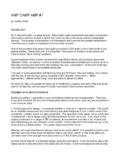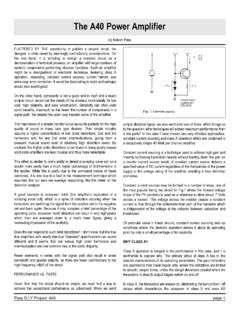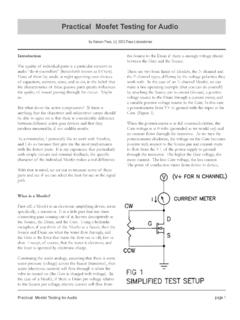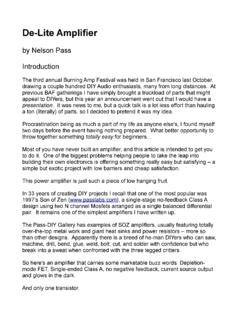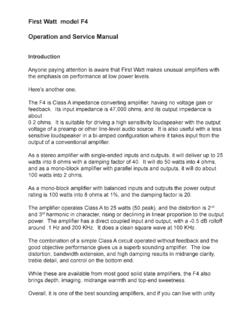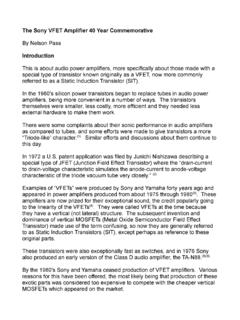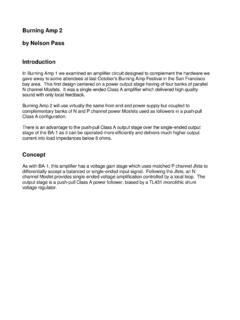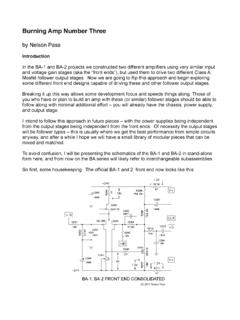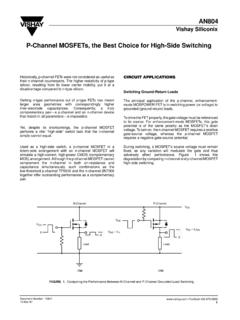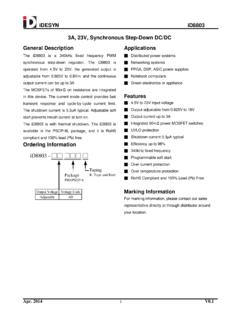Transcription of First Watt SIT-1 Power Amplifier
1 First Watt SIT-1 Power AmplifierRead Me FirstI fully realize that many, if not all, owners will rush to hook up the Amplifier without reading this operating manual. I don't blame you I don't read them either. However, this Amplifier is different in a number of ways, and if you only read this page you will probably save us both some time and and Ventilation - This Amplifier consumes 200 watts all the time and converts it into heat. Pick a location where the Amplifier can get some fresh air and blow off the heat. Do not enclose the Amplifier in a closed cabinet.
2 Don't set it on the carpet. Give it lots of Connection and Input Impedance - The SIT-1 takes a single-ended (RCA) input. The input impedance is selectable between 10 Kohms and 100 Kohms by gold jumpers which plug into XLR connectors near the RCA input:I suggest you start with the default 100K setting which will work with anything. Later you may wish to try driving the Gate terminal of the SIT device more directly by removing the gold jumper and inserting it in the 10K input position as shown. If you are running a low source impedance, you won't find much difference (at least I don't), but you can enjoy the concept of running through the absolute minimum of circuitry.
3 In either case, use whatever sounds best to you. The XLR panel connector is not an input connector Output Connection - You can hook this Amplifier up to any loudspeaker without danger of damage. Note, however that the (+) Red output connection is actually grounded. The (-) Black output terminal is the live connection. This can be important when you are hooking up active subwoofers to the output of the amp treat the Red output as ground, and the Black as Operating Point Setting - The front panel has a meter and knob to control the exact operating point of the SIT device.
4 Use the knob to initially set the meter to the center position. This position is calibrated to my favorite setting for 8 ohm speakers, and is the same as the fixed setting of the SIT-2. You can play with it later, but I suggest that you read the material presented later for some hints as to how to use maximum reliability, do not run the meter outside of the green - The SIT-1 takes a while to fully warm up. During this time you can listen to it, but you will find that the initial operating point will drift a bit and will require some ! You can go play have been building Power amplifiers for over forty years now, and at this late date I wasn't expecting much in the way of surprises.
5 In the past few years at First Watt I had been working with low Power designs using some of the new Power Jfet transistors from Lovoltech and SemiSouth which offered some performance improvements with simple circuits, so at least I felt like I was still making some incremental problem was, however, that while you can make really good sounding amplifiers with simple linear circuits, it tends toward a certain amount of sameness as they measure better. It is difficult to create something subjectively magical about the sound, something that makes people wake up and say What the hell is that?
6 As a tradition, there is really no formula for such a thing, as you are dealing with the incredibly complex neural system that sits between people's ears, and it doesn't respond to sound in the same way as our distortion analyzers and oscilloscopes. If you have experienced ears and if you know what you like when you hear it, then the approach that works is to try everything. That is largely what I do, remembering Edison's dictum invention is 2 percent inspiration and 98 percent perspiration. Sometimes, though, things just fall into your lap. A couple years ago I was talking to Jeff Cassidy at SemiSouth and he mentioned that at one time they had made a special run of Static Induction Transistor devices on some kind of military/industrial contract, and that one of their technical people had remarked that they were nearly ideal for use in audio amplifiers.
7 Really , says I, Do you have any of them left over? No the customer scooped them all up, but they would be interested in making more. The price of a small run was astronomical (to me, at least) and I spent quite a bit of time pondering the then I wrote the check and didn't look a few months I had a small batch of SITs with my name on them, and I started playing. It took about a year and a half to arrive at the designs of the SIT-1 and SIT-2 amplifiers, and it has been a revelatory SIT devices allow operation with only one gain stage. In fact the SIT-1 has only one transistor in the entire Amplifier , without feedback and even without degeneration.
8 It's as simple and raw an amplifying circuit as you could have built such simple amplifiers before using Mosfets and Power Jfets, but I was not at all prepared for the quality of sound that I got with the SITs. It was like SIT-1 and SIT-2 are special amplifiers. They have single gain stages the input signal goes into the Gate of the SIT and comes out the drain amplified and driving the loudspeaker. There is no feedback or degeneration. They run single-ended Class A, and the SIT-2, biased by a current source, has an efficiency of about 10%, and the SIT-1 , biased through 800 watts of Power resistors, has an efficiency of about 5%.
9 Both amplifiers deliver about 10 watts output per channel . The SIT-1 is a monoblock drawing about 200 watts, and the SIT-2 is a stereo Amplifier also drawing about 200 watts. So what's the difference? First off, the SIT-1 gain device is surrounded by passive components, giving it a lower efficiency of around 5%. It is biased through 800 watts of Power resistors mounted on the heat sink. The SIT-2 is biased by a constant current source created by another FET device, and it has an efficiency of about 10%. While these two approaches give nearly the same sound at the default setting, I have always been intrigued by the sound available from the SIT without any other active devices involved.
10 I suppose you could think of it as slightly more purist, if twice as SIT-1 has a knob and meter on the front panel which allows the user to adjust the load line setting of the SIT device to tweak it into the most preferred setting for different loudspeakers and listening taste. It also helps compensate for small variations in AC line SIT-2 operates a fixed operating load line as determined by listener's preferences in various systems. This setting corresponds to the middle position setting on the SIT-1 . Being biased by a constant current, it does not need compensation for AC line from these, they are very similar.
